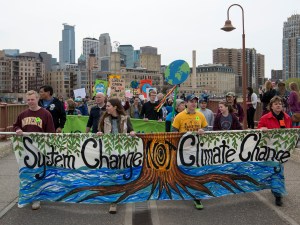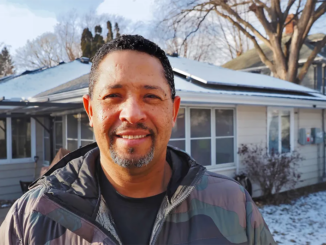
The city of Minneapolis’ newly released draft of the Climate Equity Action Plan seeks to address the climate inequities that many of Minneapolis’ BIPOC and lower-income communities face.
Environmental advocates, many of whom were part of the conversations with the city to inform the plan, say it does a good job of identifying the areas where the city needs to improve, but needs more specifics when it comes to implementation plans, most importantly, where the funding will come from.
“It has good long-term goals,” said Theresa McClenty, the executive director of MN350, a Minneapolis-based climate justice nonprofit.
McClenty wants a clear dedicated funding stream for some of the initiatives mentioned in the plan so there’s accountability for achieving those metrics. For example, the plan mentions switching Minneapolis households to clean electricity.
“Switching all homes to clean electricity will be a massive undertaking. Even though the federal government has funds available for household electrification, electric cars and geothermal; dedicated city funding is needed. That’s the piece that’s missing,” McClenty said. “We want to make sure that there’s dedicated city funding to make sure renters, transit riders, low income and communities of color are not left behind.”
The goals
The plan has several goals, like creating more safe walking distance access to stores, schools and greenspace, reducing the number of people who spend a large percentage of their incomes on utilities and reducing carbon emissions 65% by 2025, among others.
Sign up for Energy News Weekly
Get the most important energy news of the week delivered directly to your inbox.
In 2019, the city declared a climate emergency and a resolution that demanded a solution to address the consequences and causes of climate change.
“We want to be able to mitigate climate change, stop it, slow it down, but also repair past environmental injustices that have been perpetrated on our BIPOC communities,” said Kim Havey, the city’s sustainability director.
Through engagement with various communities, people shared with the city that they notice hotter and wetter climates, extreme weather events, smoke and transportation pollution, drought and high energy costs. Energy burden, which is the percentage of income spent on utilities, was a significant concern among many of the people to whom the city talked. Many renters were unhappy with the structure of the utility system, especially during emergencies, which sometimes led to insufficient cooling in the summer and not enough heat in the winter.
“Communities of color disproportionately experience energy burden,” McClenty said.
In 2019, 17,000 Minneapolis households had an energy burden of more than 6% of their income, and 5,000 had an energy burden of more than 10%. Many of Minneapolis’ homes are older, and 46% of them have no or inadequate wall insulation, according to the report.
The plan lays out a goal to complete 15,000 wall insulation upgrades by 2030, aiming to have more efficient homes and residents paying lower utility bills. With those insulation efforts, Havey said the cost of energy in a home can be reduced by 30-50%.
A coalition of various climate activist groups created the People’s Climate & Equity Plan for Minneapolis, which the city says greatly influenced the goals and recommendations of their plan.
Climate activist Kate Knuth, who is a coordinator with the Just Transition Fund coalition, said compared to other plans, this one has many strengths, like the carbon emissions goal.
“Some places we would like to see improvement is making sure the goals underneath the goal actually add up to what we say we want to do. I think it could use some more quantification of how much emissions reductions would come from the strategies and actions in the plan. We also want to make sure that there are clear timelines for implementation,” Knuth said.
The plan could also be more specific in dedicating funding to each goal, Knuth said.
“There are some nods to funding and financing, but there’s no overall approach or discussion of it,” she said.
Knuth has looked into various city climate plans in Minnesota, which have informed her opinion on Minneapolis’.
“I think the strongest plans have quantification. They have ambitious goals, which I think the overall goal of Minneapolis is ambitious. They (strong plans) have a real connection to equity. I think that’s something Minneapolis has stronger than other places. (Strong plans) have clear nods to implementation and how this is going to happen. I think the Minneapolis plan could be strengthened there. The funding and finance are like a subset of implementation and that I think needs to be improved in Minneapolis.”
Knuth was on the city’s climate plan steering committee, which had technical and community experts who served as a “sounding board and guiding voice,” according to the city’s plan.
“Other cities have taken an approach to create dedicated revenue for climate justice,” Knuth said. “The city declared a climate emergency in 2019 … so if it is an actual emergency, I think it’s important to put significant funding behind the work and mobilization that needs to happen.”
Havey said the city is still considering ways to fund the various projects and goals. It already plans to dedicate $3 million to climate action as a part of Mayor Jacob Frey’s climate legacy initiative – but it will take more than that.
“We’re proposing to increase that dramatically to meet the needs,” Havey said.
The city is thinking of various ways to get that funding through grants, tax credits, or local dollars like pollution control fees, Havey said. A proposal for that funding will come later this year.
“We’re trying to put that all together,” Havey said. “We want to make it as low (of a) barrier possible, and we want to get rid of the need to have upfront capital and financing and putting more burden on low-income families and get it all covered and paid for so that they’re ready to transition to a more electrified future, and are not left behind.”
The city also held several community listening sessions, where officials met with community groups to hear people’s priorities and concerns about the climate.
Other key points in the plan include recycling and composting 801% of citywide waste by 2030, reducing greenhouse gas emissions from commercial and multifamily buildings by 30% by 2030, and increasing the number of trips under two miles that are walked, biked, or taken via transit.
Disproportionate climate impacts
Air quality in Minneapolis varies significantly by ZIP code and ethnicity. ZIP codes with the largest percentage of residents of color had more than five times the rate of asthma emergency room visits related to air pollution compared to areas with more white residents, according to the 2022 “Life and Breath” report by the Minnesota Department of Health and Minnesota Pollution Control Agency.
Areas of Minneapolis with more tree canopies, which provide shade and absorb heat, have dramatically lower temperatures. Those factors influence health outcomes.
“We also know that communities of color also experience high rates of asthma and heart disease. We think by supporting the transition to clean energy, the city can help our community save monthly bills as well as improve the quality of air that they breathe in,” McClenty said.
Green space, which are spaces like parks and areas with natural vegetation, is another climate consideration that is currently inequitable in Minneapolis. The city’s plan contains several goals to increase the amount of greenspace and trees planted in green zones, which are designated areas of environmental concern.
The draft of the plan is open for public comments until June 5, and the Just Transition Fund coalition wants to get the word out to community members to give input on the plan. So far, the city has received around 500 comments.
MinnPost is a nonprofit, nonpartisan media organization whose mission is to provide high-quality journalism for people who care about Minnesota.



